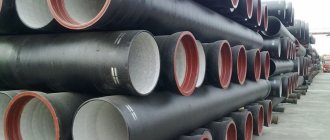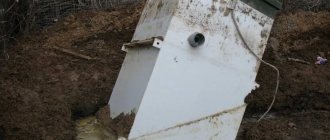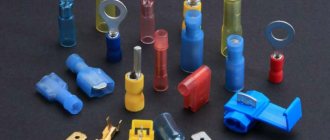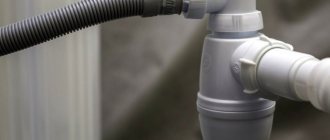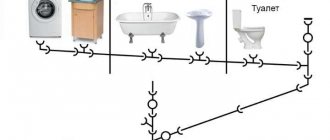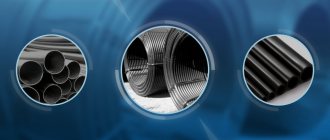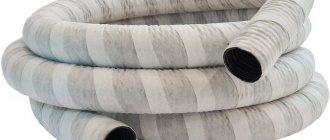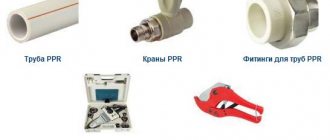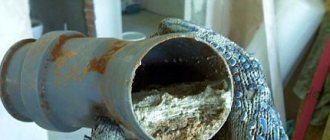A siphon is one of the mandatory elements for connecting plumbing equipment to sewer networks. It constantly contains a small volume of water, a water seal - it is simply necessary for sewerage, because... prevents the spread of negative odors. To choose a siphon, it’s worth understanding this issue, right?
We will talk about how the water seal fulfills its duties. The information presented to your attention will help you easily determine the types of device that are optimal for you personally. Reliable information will provide the opportunity to evaluate practical aspects and make an informed purchase.
The article outlines the design differences of the various models with utmost precision and describes the specifics of the installation. Step-by-step instructions, photographs and video guidance will help independent craftsmen in their work.
How to choose?
The most important element of any siphon is the hydraulic lock pipe.
All other things being equal, you should always give preference to models in which this element has a bottle design, since it is much easier to clean than models with a bend in the pipe. You should choose corrugated options only in cases where all other structures cannot fit into the available space. This is due to the fact that debris deposits often form on the corrugated walls, leading to the appearance of unpleasant odors, and cleaning such a siphon is much more difficult than products of other designs. When choosing a material, it is worth assessing the expected operating conditions of the siphon. If the location of its placement does not imply the risk of shocks and other mechanical influences, and the drained liquids will have a temperature of no more than 95 ° C, then the use of plastic products is quite justified. If boiling water is sometimes poured into the system, and the installation site of the siphon is not sufficiently protected from external influences, then it is better to purchase a product made of stainless steel or other metal.
When choosing the dimensions of the funnel, you should take into account the amount of waste that will flow into it. The more pins are connected to this element, the greater its width should be. The funnel should be taken with a margin of width to prevent the formation of splashes, as well as to ensure the possibility of connecting additional drains in the future
Another nuance that is important to consider is that the material from which the element is made must be more resistant to high temperatures than the rest of the structure.
Before purchasing a specific model, it is important to first read the reviews of people who have already purchased such a product.
Particular attention should be paid to the reliability characteristics of the siphon
For an experienced craftsman, it will not be difficult to make a structure with a flow break yourself using any ordinary siphon and funnel of suitable sizes
In this case, it is important to use a sufficiently wide funnel, correctly fit the elements to each other, ensure the tightness of the assembled system and adhere to the recommended height of the free-falling jet
For an overview of the siphon with a jet break, see the video below.
Main functions of a water seal
The siphon provides a difference in pressure levels at the inlet and outlet. This phenomenon helps to prevent the spread of gases emanating from the pipeline. For better functioning of the sewer system, pipes with an absolutely smooth inner surface are taken. Plastic in this case is an ideal option, since plastic pipes do not have burrs or roughness. The water seal associated with the toilet is usually made of earthenware, like the main product, because it is not installed separately, but is already built into the product itself.
It is this water seal that is considered the main one in the system, since the entire system can be adjusted only after installing the flush tank. After all, draining water in the tank contributes to maximum pressure fluctuations. As a result of this action, the water seals of the sinks are drained, because the water leaves under the influence of the resulting pressure difference.
Corrugated, tubular siphons
In this situation, the basis of the water seal becomes a plastic pipe. It can be either smooth or corrugated, but in any case flexible. Smooth pipes bend worse, so each bend takes up a lot of space; this does not affect functionality, but the aesthetic appearance of the room deteriorates. Therefore, corrugated systems that accommodate bends of the required length in a very limited space are more popular.
These systems have the following advantages:
- the ability to adjust the siphon loops after installing the entire system;
- the ability to move a sink or other device without disconnecting the siphon.
Sewer check valve: device design options
Check valves for sewerage are classified according to the type and operating principle of the shut-off element. There are petal, ball, wafer and lifting devices.
Rotary (petal) check valves have a spring-loaded circular diaphragm that is attached to the top inside of the body. At the moment of free movement of masses along the sewer pipe, it is raised upward. When a reverse flow of liquid occurs, the plate rotates and is pressed against the rim of the inner surface of the outlet pipe, sealing the cross-section of the pipe hermetically and tightly. Some devices may be equipped with a manual shutter, which is represented by a second membrane, which is controlled using a button.
The check valve has larger dimensions compared to the sewer pipe. When installed, narrowed and expanded zones are formed, which are an ideal place for the formation of blockages. A removable cover, which is located in the upper part of the device body, will help eliminate such troubles. In this regard, it is not recommended to install a rotary type check valve (40 mm) for sewerage.
The ball check valve is equipped with a ball-shaped shut-off device. In this regard, such models have a specific internal structure. In the upper part of the body there is a special recess where the ball is located when fecal fluid flows unhindered through the pipeline. When the movement of wastewater stops, it rolls out and blocks the gap in the pipe, preventing the reverse flow of wastewater.
All valves can be classified according to the design of the shut-off element and the type of device. Please note! Such a valve does not exclude the possibility of drainage leaking in the opposite direction, which occurs due to a loose fit of the ball to the side wall of the housing.
Both 50mm diameter options are the most common in the system. The devices are able to withstand high pressure, which is typical for a multi-story building system.
Dry shutter device
The most common devices:
- Membrane. Under the pressure of water passing through the drain, the valve opens, and after the water passes, the spring moves the membrane to its original position. Access to unpleasant odors is reliably blocked.
- Float It works due to the fact that the float is always on the surface of the water seal, and when the water evaporates, the float ends up at the very bottom and closes the passage.
- Pendulum. Under the influence of gravitational forces, the mechanical device constantly strives to occupy a position that blocks the sewer pipe.
- Based on the molecular memory properties of the material. Tubes made of elastic material are used, which always tends to return to its original shape.
Dry and combined drains are made from durable materials (mainly plastic housing and stainless steel grate) using modern equipment. The model range of these devices is expanding; you can select a dry drain equipped with a check valve to protect against the entry of wastewater from the sewer system into the room in case of flooding, as well as select models that can be used in unheated rooms at sub-zero temperatures, as well as heavy-duty, capable remain sealed under significant impact loads.
Water sealing mechanisms in the kitchen
Due to the above features, the installation work of the kitchen drain will be different. In some cases, preliminary assembly of the elements is required, and in some cases, the assembly of the drainage system occurs during the installation of the sink itself. If the sink drainage device has a complex plastic design, it is worth checking the elements for cracks and burrs, so as not to break the tightness of the water drain.
Installation of the flask
When installing the flask, the water seal is equipped with a gasket, the lid is attached, and the drain pipe is connected to the water seal glass using a nut and sealing gaskets. Next, the siphon is connected to the sewer pipe and secured.
Installation of corrugation for outlet
The next step is to install the corrugation, which is inserted into the drain to prevent leaks. If the sink has an overflow system, then the installation is carried out according to the same scheme that is used to install a washbasin in the bathroom.
Installation of a siphon with two sockets
If the kitchen sink is equipped with two compartments, then you need to use a siphon device that has two bells. A special feature of the installation work is a more thorough check of the connecting elements of the device and carrying out hermetic work with the two openings of the sink.
To connect a dishwasher or washing machine to the siphon, you must purchase two fittings for drainage. The hoses leading from the dishwasher to the drainage system are fastened according to a certain pattern; the method of fastening depends on how the fitting is mounted, with an angle or straight.
Clearing the blockage
Since the most common cause of poor water seal performance is a typical blockage, you can mostly solve the problem yourself, without the help of a plumber.
Cleaning the knee
To begin with, you can try the most common methods - cleaning with a plunger or using special cleaning products. If this does not help, then a more effective method would be to clean the siphon itself. To do this, you need to carefully disassemble the siphon, first place a basin or put a rag under the drain and clean it using household products. It will not be superfluous to disinfect the internal surfaces.
Plumbing cable
If the result is not achieved or it is insignificant, this indicates that the cause of the blockage is not in the siphon, but literally deeper - the pollution is clogged in the drain pipe itself. Then you need to call a plumber, but if you have a plumbing cable in your arsenal, then you can do the operation yourself. To do this, you can use the following algorithm of actions:
- Unscrew the top nut connecting the siphon to the drain hole
Unscrew the lower nut (the junction of the siphon with the sewer)
Prepare a bucket or other container and then remove the shutter itself
Insert a plumbing cable into the drain pipe
Thread it all the way in (your hand should feel resistance)
Use a rotating motion (using the handle) to clear the blockage.
It happens that the pipe looks like a coil and has many zigzags. This is not a reason to refuse cleaning - you can insert the cable through a special window on the side. In this case, you need to act according to the following algorithm:
- Unscrew the special cap and immediately place a bucket - most likely, a large stream will pour out
Carefully push the cable into the hole
Push it all the way
Rotate the handle until the debris is completely removed.
Manufacturing process
First, we take a clean and fresh plastic bag, straighten it, but do not unfold it (as if we wanted to put something in there).
Approximately in the center of the bag, use scissors to make a small slit.
Then insert the tip of the rubber tube into this slot.
Next, we wrap the section of the bag on the rubber tube next to the slot with thread. Having wound it well enough, we tie the ends of the threads with two or three knots.
Moreover, the winding with threads must be done tightly enough so that eventually the rubber tube in this place shrinks a little to ensure tightness. The tip of the rubber tube protruding from the bag should be within 15-20 mm.
Well, that's basically it.
The simplest water seal is ready!
Now all that remains is to install this water seal on the neck of the container in which we contain the fermenting wort.
In this case, I will install our water seal on a three-liter jar. To do this, it is advisable to first rinse our water seal with warm boiled water (but not hot).
Then we put a water seal on top of the neck of the jar.
Then, through a rubber tube, we put several rubber bands folded in two or three times onto the neck of the jar.
This way we seal the plastic bag around the neck of the jar.
The ends of the bag can be straightened out to create fewer wrinkles.
Place the tip of the rubber tube in a jar of water.
And now our water seal is already standing and starting to work.
By the way, notice in the photo above how the top of the plastic bag on the neck of the jar has risen and inflated a little. This suggests that everything is normal, that is, our water seal is airtight, it well holds the pressure of carbon dioxide released from the fermenting wort
Also, after some time, gas bubbles began to emerge from the end of the rubber tube lowered into a jar of water. Unfortunately, I couldn’t really photograph them, since it turned out that it is very difficult to catch the moment when the next bubble is released. That's why I don't include photos.
However, I will immediately note that the presence of these two factors, that is, the swelling of the upper part of the polyethylene of the water seal, as well as the presence of bubbles released from the rubber tube, is one hundred percent confirmation that the water seal is correctly made and installed, and fermentation is proceeding as normal.
If the two above factors are absent, this means that the water seal is not airtight.
By the way, the tightness of the water seal can be quickly checked in the following way.
To do this, you need to remove the tip of the rubber tube from the water, carefully shake off the remaining water inside and blow lightly into the rubber tube. You should not blow very hard, but so that the upper part of the polyethylene on the water seal is inflated. This pressure must be held for three to four seconds, while you need to carefully look at the water seal.
If the polyethylene gradually deflates, and you also hear a sound or a slight whistle from the escaping air, it means that the water seal is not airtight.
Leaks can be caused by three reasons.
The first two are a weak connection between the rubber tube and the plastic bag, or weak tension in the rubber bands pressing the bag to the neck of the jar.
These two reasons can be easily corrected; it is enough to tie the bag tightly to the rubber tube with threads, or it is better to wrap rubber bands around the ends of the bag on the neck of the jar. Here you can also use other longer rubber bands instead of rubber bands, or even wrap the neck with a rope, or maybe even electrical tape or tape (although I think this is unnecessary).
The third reason for leakage may be that the plastic bag itself is damaged. It may be punctured or scratched by something. Although, to be honest, this has never happened in my practice, since after all, the walls of a plastic bag are quite strong and you need to try very hard to damage them, for example, by poking them with something sharp.
However, in this case, you will have to replace the entire package, that is, essentially, re-make the water seal, although in principle this is not at all difficult and will not take much time.
In general, it should be noted that despite the apparent flimsiness, this water seal is very reliable. Suffice it to say that I have been using this type of water seal for many years, and it has almost never let me down.
So I can recommend to all home winemakers who have a need to make a water seal to use the design I proposed.
Well, that's all for me!
Water seal options
A water seal is an important element of the sewer system, the purpose of which is to cut off unpleasant odors coming from the septic tank (drainage pit). Simply put, this is a water plug that remains in the pipe even if the bathhouse is not in use. An example of the simplest water seal is a U-shaped siphon. In a pipeline made of plastic pipes, a water plug is created using three shaped elements: bends.
The difficulty is that when the sewer system is rarely used, the water in the water seal tends to evaporate. In this case, experts recommend installing a dry shutter. It is a simple plastic or metal structure equipped with a spring and a valve (membrane) that blocks the exit from the pipe. When water enters the system, the damper is folded back under its pressure, and after the flow passes, it returns to its place.
Craftsmen make unique homemade valve systems for bath drains. If you wish, you can use one of the following options.
| System Description | Illustration |
| A plastic funnel with a diameter slightly larger than the cross-section of the pipe and an outlet with a diameter of 3 cm is installed in a vertical position into the gap in the sewer pipe. A plastic ball (for ping-pong or other) is placed in the funnel of such a size that it blocks the narrow exit. When water gets into the pipe, the ball floats up. | A funnel and ball valve. Example for clarity |
| To install a dry seal for a plastic sewer with a pipe diameter of 50 mm, you will need a 50/110 adapter, which needs to be slightly modified: cut at an angle and attach a circle of thick rubber to it. After which the structure is installed at the outlet of the pipe in a septic tank or drainage pit. | Dry shutter Dry seal in the sewer pit |
Varieties
Gates can be divided into two main categories - mechanical and electrified. Within each category, in turn, several more subspecies can be distinguished.
Mechanical
A typical modern mechanical valve is a polymer body in which a profiled stainless steel valve is movably mounted. Its normal position is closed; the damper is oriented with its concave side towards the gate inlet.
The valve must be oriented relative to the direction of movement of the waste in a strictly defined manner. The direction of wastewater flow is usually indicated by an arrow on the housing.
The shutter cover is removable. The hatch is necessary for servicing the valve and cuffs that ensure its tight fit to the saddle.
During normal sewer operation, the wastewater pressure lifts the damper; in counterflow, the excess pressure at the outlet, on the contrary, presses it tightly against the seat seal.
Since the speed of movement of wastewater in a gravity sewer is low, dirt inevitably builds up on the sealing collars over time. Accordingly, the shutter needs cleaning.
This is done in two ways:
- Once every three months, one or two buckets of water are poured into the toilet, located as close as possible to the valve. The volley release ensures that water moves at a sufficiently high speed to flush the sealing collars;
- Once every six months to a year, the valve hatch is opened, and the seat and cuffs are cleaned mechanically. You can clean them with your own hands, using a regular toilet brush, or with a stream of water from a hose. The technological hatch cover can be removed without the use of tools.
On sale you can find several subtypes of mechanical shutters:
- Single chamber;
- Single-chamber vertical;
A sewer drain with a dry valve is a special case of a single-chamber vertical valve.
- Single-chamber, providing for manual fixation of the damper;
I have encountered the use of a conventional wedge water valve with a diameter of 100 mm, welded into a sewer gap, as a valve with manual fixation. Despite its advanced age, it performed its functions perfectly when the yard drainage system was clogged. The debris that got under the cheeks was simply ground up when closing.
- Two-chamber (with manual fixation of the damper in one of the chambers).
Electrical
How does a typical electrified shutter work?
- It is equipped with two cameras. One chamber is equipped with a conventional mechanical shutter, the second with an electric drive;
The mechanical damper provides manual locking in the closed position.
- The filling sensor located inside the housing is responsible for the activation of the electric drive;
- Each chamber is equipped with its own maintenance hatch;
- The control unit monitors the valve position and transmits information about it to the dispatcher;
- If necessary, the electrically driven shutter can be closed forcibly;
- Optionally, the shutter is equipped with a battery capable of maintaining its operation in standby mode for a week.
Reasons for water seal failure
Sometimes a sewer valve may fail, which occurs for a number of reasons:
- Water hammer in the sewer system, resulting in a water plug leaking. The drainage pipe becomes accessible to the penetration of unpleasant odors.
- Vacuum plug in pipes due to a large flow of water that enters the sewer from the drainage tank, which leads to blockage of the pipe.
It is important to understand that high-quality maintenance can ensure the uninterrupted operation of the bath sewer system. Bath drains are reliable protection against the penetration of foul odors and gases from drainage pipes into the room
Such devices can be purchased ready-made or built with your own hands. In terms of performance characteristics, homemade valve designs are absolutely not inferior to factory-made analogues
Bath drains are reliable protection against the penetration of foul odors and gases from drainage pipes into the room. Such devices can be purchased ready-made or built with your own hands. In terms of performance characteristics, homemade valve designs are absolutely not inferior to their factory counterparts.
Any capital structure - a house, a cottage or a bathhouse - requires a reliable sewer system. The sewerage system installed in the bathhouse will ensure safe removal and treatment of liquid waste.
Only if technological standards are observed during the construction of the drainage system, the homeowner will be able to carry out the work efficiently and in the future enjoy health-improving water treatments in the bathhouse.
How to clean a drain at home without the help of professionals?
A clogged pipe - how to clean it At least once in our lives, each of us has a situation when a clog forms in the sewer system and it fails. Most often, this unpleasant incident happens unexpectedly, when no one is expecting it. Then you have to do something urgently. It is not always possible to wait for an experienced plumber, so the vast majority of “victims” try to solve the problem on their own. Let's see how you can clean your home drains yourself without professional help.
But first, let's clarify one important question...
Types of water seals
There are different designs of water seals that work on the same principle, but are implemented in different ways. The following types are common:
Knee
This is the same U-shaped design option, the simplest and most reliable. The crank lock can withstand significant loads. The length of the water column is large enough to ensure the shut-off of pressurized biogas or to carry a burst discharge of large quantities of wastewater. Most often, knee traps are installed under bathtubs, showers or dishwashers. In addition, the toilet and bidet designs also contain knee water seal options.
Example of corrugation and U-shaped version
Bottle type
This design is familiar to anyone who has had to look at a siphon under a kitchen sink or bathroom sink. It is a plastic container that contains a vertical drain pipe. A drain pipeline connected to the sewer comes out of the tank on the side. The vertical inner tube is immersed so that its cut is below the level of the side outlet. This design not only provides a reliable water stopper, but also forms a container for food scraps and other organic waste. When it is full, the outer part can be opened by unscrewing the cap from the bottom and the container can be cleaned. Bottle siphons are made of polypropylene and are less durable than elbow designs. The threaded connections are unreliable, which requires fairly frequent replacement of the siphon.
Double-turn water seal
Another name for such a siphon is a pipe siphon. It is a slightly more complicated version of the knee type, equipped with a removable knee or inspection hatch in the upper part of the bend. A double-turn water seal in the sewer system is found in old houses, industrial enterprises and other premises where the internal sewage system was installed a long time ago. Currently, this design option is rarely used, since the configuration of bathrooms does not allow its use.
Corrugated siphon
The simplest option, which is a flexible corrugated pipe, bent in the shape of an elbow and connected with a plastic clamp for immobility.
The design is very simple and can be done by hand. However, the inner surface of a corrugated pipe is poorly cleaned of small debris, hair, organic particles and, in particular, heavy particles - sand, cement chips, etc.
The hydraulic valve in the sewer, made of corrugated pipe, requires constant attention and frequent cleaning, which creates a certain inconvenience for the user. At the same time, such a tube can be purchased separately and simply replace the problematic element. It is inexpensive and can be found in any plumbing store. Before making a water seal for sewerage from a corrugated pipe, you should install a grill on the drain hole to protect it from small debris.
Water seal for storm drainage
This refers to non-industrial storm sewerage, which ensures the removal of rain or melt water. We are talking about the internal variety - all sewer receiving devices that are located at floor level are also called storm drains. These are funnels or drain holes in shower rooms located in the concrete floor screed. This group also includes drain holes in saunas or baths, swimming pools, etc.
They are distinguished from industrial stormwater systems by the type of wastewater - basically, it is ordinary water without large and solid particles. A feature of such siphons is their small size, forcing the use of bottle-like structures. To clean, lift the top grill, which protects against the entry of foreign objects.
Where can I buy
You can purchase a water seal for sewerage at any plumbing store, as well as in many hardware and construction supermarkets. The cost of a product is influenced primarily by its type, size and brand. To a certain extent, the price is also affected by the region of the Russian Federation in which the purchase was made.
For example, in Chelyabinsk (Santekhorbita, EuroDom stores, online store World of Plumbing) and Rostov-on-Don (online store SantekhMega, SantekhOpt, Three Inch stores) similar products are sold on average 10% cheaper than in the capital (“Plumbing Store”, “House of Plumbing”, “SUpSan”), Tyumen (“Water Magician”, online stores “Ark” and “Aquatoria”) and Novosibirsk ( online store “Plumbing of Siberia”, m-ns “Meduza” and “AquaTermService”).
Installation of water seal on sewerage
The siphon devices produced today are so clear and simple that installing them in place in the system is extremely simple and anyone can do it themselves. Let's look at a few examples:
- A self-formed water seal device can be made from a piece of pipe and several standard fittings.
The use of additional sealing in the form of sealant will ensure long-term operation of the device.
- In the same way, a drain connection is formed in a shower or bathroom, and it can be connected directly to a collector pipe with a diameter of 110 mm.
If cleaning is necessary, the device is simply dismantled and then put back together.
Considered the most difficult to install, a bathtub water seal can easily be made using a corrugated plastic hose. The corrugation is used for the overflow device, which is also a mandatory element of the plumbing piping of the bathtub, and the siphon can be used either as a single piece, selected according to size, or from the same hose
The inconvenience of working in cramped spaces forces us to pay special attention to the quality of installation of fasteners - without distortions and strictly according to the thread.
- The easiest way is to connect a bottle water seal to the kitchen sink.
To do this, you need to install the upper funnel into the hole in the sink and tighten the clamping nut. Before this, a gasket is installed under the funnel. Do not over-tighten the nut; it may dislodge the gasket from its conical seat and cause a leak.
After this, the casing is put on the pipe and secured with a nut. The corrugated pipe is led from the body to the inlet rubber bushing at the opening of the sewer pipe. The sleeve is selected to match the outer size of the hole, and the inner size to match the diameter of the corrugated pipe tip.
Watch the video
How to make water seals with your own hands
The need for a siphon in the sewerage system is absolutely obvious. How to make this simple but important detail with your own hands? To do this, it is best to use standard fittings of the required size. Of course, you need to have the skills to solder plastic pipes using special equipment - a soldering iron.
Watch the video
But this is a simple art and learning it is not difficult and does not take long. The device can be rented on a daily basis without spending any money on purchase.
Water seal for sauna sewer
A water seal is a specially created water plug that prevents sewer “odors” from entering the room. Water accumulates in the curved section of the pipe, completely blocking the diameter. Thus, water prevents odors from penetrating into the room.
The principle of organizing a water seal for sewerage
When to use a water seal in a bath
In a bathhouse, you need to use a water seal for the sewer if the water drains into the general drainage system. If the water is drained outside the bathhouse into a pit, from where it is absorbed, there cannot be any smell in this case.
If the bathhouse sewerage system is connected to a common system, you can use ready-made siphons (as for a bathtub or washbasin) of any design. Plastic or metal bottle-type closures or corrugated hose closures are available for sale.
Bottle type sewer seal
Sometimes you can still find a cast iron water seal, but their production stopped several years ago, and they are found mainly in old houses.
This is what a water seal for plastic sewerage looks like
CENTER AQUAPA water seals are available for sale, which are inserted into a plastic pipe with a diameter of 55 mm or 110 mm.
The CENTER AQUAPA water seal is inserted into a pipe with a diameter of 110 mm
In essence, the water seal consists of two glasses inserted into one another.
Upper and lower parts of the CENTER AQUAPA water seal
After pouring the floors in the bathhouse, the top of the water seal should be in a small recess to completely drain the water.
The upper part of the water seal is at the level of the lowest point
This water seal has two advantages:
- It additionally serves as a settling tank;
- Even if the water freezes in the water seal, it will not be damaged.
How to make a water seal with your own hands
You can make a water seal with your own hands quite easily. To do this, a piece of pipe of suitable diameter must be bent in the shape of the letter “U” and welded (connected using couplings) to the pipe after the drain funnel (the height of the water seal is usually 50-70 mm). It is advisable to do this while laying the foundation and arranging the floors, but if the bathhouse is already functioning and the smell bothers you, you can try to eliminate this nuisance.
If the foundation is columnar and sewer pipes are accessible, this makes things easier. Under the bathhouse, you can weld the required piece of pipe to the drain pipe. If there is no access to the pipes, you will have to organize it: dismantle part of the floor if it is wooden, or cut it out with a grinder if it is concrete. Then connect a bended pipe to the sewer using couplings or welding.
It is necessary to take into account that water evaporates from any water seal. And if you do not use the sewer for a long time, after 40-50 days it will completely dry out, and gases from the sewer will freely penetrate into the room.
What is a dry water seal
There is another option for a water seal - dry. There is no water in it, and various materials are used as a damper. As you understand, such a water seal does not freeze. There are several types of dry water seals for sewerage:
This is a membrane that is held in place by a spring if there is no water. When water enters, the power of the spring is not enough to hold it, the damper rises and the water drains.
This is what a drain with a dry water seal looks like
- An object of a certain shape (usually a ball larger than the diameter of the pipe) blocks the air passage. As soon as water enters, the object floats up, opening the drain.
- More technologically complex models that use molecular memory of materials.
For a bathhouse, you can make a basic dry water seal with your own hands, it’s quite simple. You need to choose a plastic ball slightly larger than the drain pipe. Put it on the pipe and make some kind of chamber within which it will be located. When there is no water, the ball blocks the access of air from the sewer. When water enters, it floats up (within the chamber) and releases the drain. This system is also functional in winter conditions: even if the ball freezes to the drain, a little hot water will melt the ice in a matter of minutes, and the system will function normally.
Operating principle and advantages
The device is a vertical or horizontal tube with a polypropylene body and threaded shanks. One of them is connected to the plumbing fixture, and the second to the sewer pipe. Inside the body there is a shutter device that operates on the principle of a check valve. When the washbasin or shower is not in use, the valve closes the cross-section of the pipe and does not allow the smell from the sewer to pass through.
A siphon with a dry seal (unlike a water one) also plays a regulatory role - it does not allow waste water to move in the opposite direction. This function is especially important for plumbing fixtures installed on the lower floors of apartment buildings: in the event of blockages, the liquid often flows back into the building. If the room is semi-basement, rising sewage drains can lead to flooding.
A siphon with a check valve has a number of positive features:
- reliable in operation, does not require regular checks;
- does not require water - therefore it is widely used in rooms without heating;
- made of polymer anti-corrosion material that meets all technical requirements;
- easy to install, does not take up much space, allows vertical and horizontal installation;
- prevents stagnation of water in the drain and, accordingly, the proliferation of microbes harmful to human health;
- durable;
- does not create noise during operation.
The big advantage of a dry siphon is its resistance to blockages. The drain pipe is only used when the valve is opening. Contaminated wastewater passes unhindered into the sewer system; fat does not have time to deposit on the walls and does not form plugs. A dry water seal is especially useful in a dacha: it does not freeze in winter and does not require extensive flushing to eliminate stagnant odors.
Varieties
The valve models differ in size, design and purpose (dry siphon for sink, toilet, shower drain).
Based on their design features, siphons are divided into several groups.
- Membrane. The role of a valve in it is played by a spring-loaded membrane. Under the pressure of the liquid, the spring compresses, opening the sewer hole for the free passage of waste. When the pressure disappears, the membrane returns to its original position and ensures a tight seal.
- Float In fact, this is a combined model, which is a combination of hydraulic and dry options. The design consists of a siphon with a vertical outlet with a float valve inserted into it. When there is enough water in the water seal, the float stays afloat and allows waste to pass through. If the tap is not used for a long time, the liquid in the drain dries out, the valve drops and clogs the hole.
- Pendulum. In this design, the valve is fixed at one point. Passing drains put pressure on it, causing it to deviate from its axis. When the pressure stops, the pendulum takes its previous position under the influence of gravitational forces and closes the hole.
Recently, models of dry locking devices with working elements made of materials with molecular memory have appeared in the retail chain. Thanks to this property, the valves operate reliably and tightly seal the drain.
Why is a water seal needed in a bathhouse?
Regardless of the size of the bathhouse, an important point is the organization of water drainage. Excessive accumulated water can lead to liquefaction of the soil, as a result of which the structure of the structure - the foundation or walls - will begin to collapse. An important element of the drain is the water seal for the bath, which is installed in the case of organizing water disposal into the sewerage system. If this is not done, unpleasant odors and gases will penetrate into the room and not only cause discomfort, but will also increase the risk of fire.
Now you know what a water seal is and why it is necessary to use it on all plumbing fixtures in the house
It is important to choose the right devices for each specific situation. In addition, regular preventative measures and cleaning of the system will increase the service life of the water seal.
Principle of operation
A hydraulic valve can be considered a type of sanitary siphon. The small volume of water inside helps make the atmosphere in the serviced building more comfortable. Normally, the liquid should be present in a special device continuously. But with prolonged inactivity of the toilet (urinal), the natural evaporation of water will gradually lead to a loss of protective properties. Therefore, it is inevitable that an odor will occur during the first flush after a long break.
However, when sewerage is actively used, the supply of liquid in the hydraulic seal is renewed. Therefore, it is possible to successfully contain the entry of bad odors
The normal operation of fan ventilation is critically important, because without it, the shutter is likely to fail. With this development of events, the liquid passes into the system
Of course, there can be no question of completing the main task. But this should not be regarded as a drawback of the operating principle of the device: with proper setup and operation, problems are eliminated.
Rules for installing liquid shut-off valves
The instructions for installing such fittings often do not cause difficulties even for amateurs.
It consists of 5 main actions:
Personal toilet valve.
- The device cuts into the point of connection of 2 sectors of the pipe or at the point where the sewer pipeline is connected to the plumbing, for example, to the toilet;
- If the fittings are mounted horizontally, then they must be set clearly in level, without distortions;
- The same devices that cut into vertical and inclined systems can be installed at any angle;
Operating principle of a vertical membrane structure.
- When assembling a sewer pipeline, the connecting sockets must be directed towards the movement of the liquid. You need to pull out the pipe sector and insert the valve neck into the socket in its place, then cut off the excess from the pipe you removed and insert it into the valve on the other side;
- At the last stage, the check valve or pipes on both sides directly next to the lock must be firmly secured with clamps to the floor or nearest wall. This should not be neglected, since the operation of such equipment causes slight vibration, which means that sooner or later the connection may depressurize.
As you can see, the instructions for installing a check valve with your own hands are not complicated, but there are a lot of little things that need to be taken into account.
Horizontal valve with two plugs.
- On each check valve, regardless of the model, there is an arrow indicating the direction of fluid movement, so before installing the device, find this arrow;
- It would be a good idea to check the device for leaks before installation. To do this, take the device, pour water into it, like into a glass, from the side through which it should not pass and leave. Typically, leaks are caused by trapped debris or an old gasket;
- The pipe stop must be installed with the same cross-section as the pipe itself. Any adapter greatly increases the risk of blockage, plus these are additional connections, and the fewer of these connections, the more reliable the system;
- And finally, such equipment is installed to prevent emergency situations, which means it must be provided with unobstructed, convenient access in case of cleaning or inspection.
Plastic check valve 110 mm.
The most difficult thing is to install such equipment in multi-story buildings. The ideal option is to install shut-off valves at the entrance to the central riser pipe.
But the thing is that the dimensions of the bathrooms in most of our houses are, to put it mildly, modest, and the valve for a pipe with a cross-section of 110 mm is a voluminous thing. So the owners have to install several personal valves for each drain instead of one capital common valve.
In the literature, I came across a proposal to install a similar lock on the access riser, just below the first floor drain. But this can be justified only if blockages regularly occur not in the riser itself, but in the central sewer well or main line, which, believe me, happens extremely rarely.
Check valve with 90º rotation.
The fact is that installing the valve just below the first floor is virtually useless. Think for yourself, the water does not come from below, the pipe is filled by draining wastewater from the upper floors. If there is a blockage in the basement on the riser, then the system will fill up to the valve, it will close and the system will continue to fill further, which means it will flood the first floor.
Insertion of the shutter into the central drain.
In private houses, as a rule, there is enough space, but there is no point in installing such a valve in a residential area. Flooding can only come from the side of a septic tank or a common central sewer line.
Accordingly, it is better to install the device either in the basement or in a separate insulated well, equipped specifically for installing a shut-off valve.
Design with manual flow blocking.
When installed on drainage system outlets, all outlet pipes must be equipped with locks. In this case, there is enough space in the well and almost any model can be mounted, but here it is better to install valves with floats.
Floats are the same petal system, only a float is connected to the rotating rod of the membrane. When the tank is filled, the float floats up and the valve closes. This process is clearly shown in the video in this article.
Options for metal shut-off valves.
Laying a drainage sewer system
Such a drainage system is more suitable for small steam rooms designed for a small number of visitors. Sewerage in a bathhouse based on drainage is arranged as follows:
- A drainage well is installed next to the steam room to a depth below the soil freezing level (up to 150 cm).
- A clay layer (no more than 11 cm) is poured onto the bottom of the prepared pit to prevent wastewater from seeping into the ground.
- The clay is covered with a composition of expanded clay, crushed stone, gravel and sand up to 50 cm thick. Bulk materials are used to create a drainage cushion.
- A layer of soil is poured over the drainage and compacted thoroughly.
- The drainage well is equipped with a special gutter, which is used to drain wastewater into earthen trenches.
- The sewer pipe laid from the bathhouse to the drainage well is insulated. This will prevent it from freezing during the winter.
If the drainage sewer is laid on sandstone, the drainage well can be replaced with a drainage trench up to 110 cm deep and up to 35 cm wide. The upper part of the trench is protected by a crushed stone layer 25 cm thick. This ensures that the wastewater will be discharged into the drainage base.
Why is this necessary?
With rare exceptions, sewerage is discharged outside the building below ground level. There are several reasons for this:
- Temperature regime of the soil
. Below the freezing level, the soil has a temperature of 8 - 12C, which allows you to not worry about pipes freezing; - Protection from mechanical damage
, which is provided by deepening the outlet to the well; - Finally, buried pipes do not clutter up the yard
and do not create obstacles for transport and pedestrians.
At the same time, the basements and ground floors of many buildings are used for warehouses, administrative offices, gyms, etc. Often, plumbing fixtures are installed in them, and their sides are significantly lower than the well cover.
When a sewer or yard drain becomes clogged, the level begins to rise. Much earlier than it reaches the level of the well cover, the wastewater begins to flow to the plumbing fixtures in the basement.
We are talking about the drains of the entire house, or even several houses, since the exploited basement floor turns out to be the lowest point in the sewer network backed up by a clog.
Sewage check valves and gates eliminate the counterflow of wastewater: as soon as it begins to flow into the building from the outside, the lumen of the pipe is completely blocked.
Types of water seals
There are several types of these devices:
- knee;
- bottle;
- dry.
Knee water seal
This is the simplest device. It consists of two U-shaped pipes that are connected in the shape of the letter S, or a corrugated hose, also bent in the shape of the letter S. The advantage of knee siphons is their ability to withstand high pressure. The throughput depends on the diameter of the pipe or hose.
Disadvantages include difficulty in cleaning. If the siphon is made of tubes, then if necessary, it may be difficult to clean it, since the structure is not collapsible.
If it is made of a hose, there will be no problems with cleaning. Also, knee water seals can be equipped with an additional hole for connecting a washing machine or bathtub overflow.
Bottle water seal
This design performs two functions: a sump and a locking device. The tube connected to the drain hole is located in the container. The container has its own outlet which is connected to the sewer. The end of the drain pipe is located below the level of the outlet, which provides the effect of a water seal.
The devices are collapsible and are made mainly of plastic. The lower part of the sump is equipped with a threaded cap, which can be unscrewed to clear the siphon of sediment. The drain tube and container are connected using a nut.
Such a connection is weak and unable to withstand pressure from large amounts of water. Therefore, they are installed mainly on sinks and are not suitable for bathtubs.
Features of the bottle siphon
The bottle siphon is the most common. It can be disassembled, so this type is easy to repair by replacing individual elements. If a valuable item falls into the water inlet, you can quickly get it out by disassembling the siphon and rinsing it. Its compact dimensions allow the use of a bottle siphon in the pedestal of a tulip sink.
In their shape, such devices can be S-shaped or P-shaped. The inspection cover is installed on top, this allows you to monitor the condition of the siphon and its contents.
